Brazil
Brazil‘s Lithuanian community is the largest in South America, although its exact numbers are disputed. Lithuanians migrated to Brazil mainly between WW1 and WW2, when 35% of Lithuanian emigrants chose this country, some 25000-50000 in total.
At the time, Brazil was rather poor and Lithuanians were attracted by jobs and promises of cheap land. Although the reality was less rosy, Lithuanians, eventually drifting to Sao Paulo, not only built homes and raised children but also created some of the most extensive Lithuanian sites outside Lithuania.
Sao Paulo is the home to Vila Zelina – a Lithuanian district that is furthest away from Lithuania. Sao Paulo suburbs host Lituanika, a unique Lithuanian-majority village. Additionally, tens of streets all over Brazil have been named after Lithuania and Lithuanians; Lithuanians have built numerous important buildings while their influence on Brazilian society is represented in several museums.
This article covers everything.
Sao Paulo Lithuanian district – Villa Zelina
Sao Paulo (Latin America's largest city) hosts the only true Lithuanian neighborhood in South America - Vila Zelina. Its construction was carried out ~1934 when the Lithuanian immigration had peaked.
The district is centered at the Lithuanian Republic Square (Praca Republica Lituania), so-named on 1976 10 31. The square is adorned by a Lithuanian Freedom Monument with the Columns of Gediminas symbol and lyrics of a song "Lithuanians we are born, Lithuanians we want to be" written on it.
The Monument is a copy of a similar monument in Kaunas. When the Sao Paulo monument was unveiled in the December of 1985, the original had been long since destroyed by the Soviet Union occupational regime, giving the erection of the monument in communist-free Brazil a symbolic meaning. The original monument in Kaunas has since been reconstructed, however.
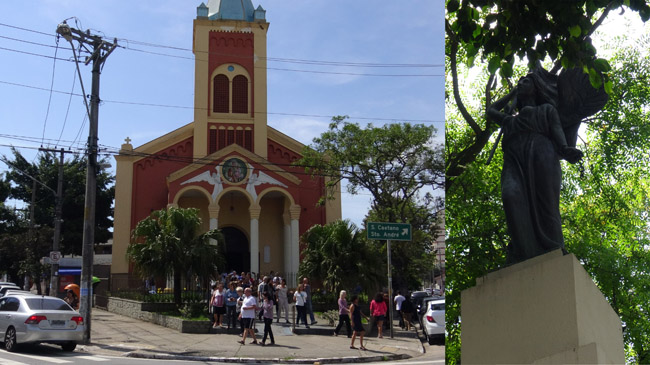
Freedom Monument (right) and the Lithuanian church in the Lithuanian Republic Square ©Augustinas Žemaitis.
Lithuanian Republic square is a convergence of 7 streets. One of them is named after a Lithuanian priest Pijus Ragažinskas (Pio Raganzinskas, 1907-1988). He had established a Lithuanian-Brazilian newspaper "Mūsų Lietuva" (Our Lithuania) that was published from the January of 1948 until 2016. Rising above the square is St. Joseph Lithuanian church, constructed in 1936 under the direction of priest Benediktas Sugintas. A Lithuanian wooden cross (UNESCO-inscribed art form) stands in front of the church (1949). In the interior one may find various Lithuanian details and paintings. The St. Joseph Lithuanian community (parish) has been established in 1931 and organizes secular as well as religious Lithuanian activities.

St. Joseph Lithuanian church of Sao Paulo and Lithuanian cross
It was the construction of the church that helped make Vila Zelina a Lithuanian district. The real estate developer of the district gifted a land plot to the Lithuanian Catholic Community (est. 1928) on the condition that the church would be built in two years. This proved to be not a simple charity but also a wise economic move: soon afterward, the nearby plots were acquired by Lithuanians who sought to build homes not far away from a Lithuanian church and activities.
The interior of the church has many Lithuanian signs. Next to the entrance, there is a commemorative plaque for Benediktas Sugintas, the builder of the church (bilingual Lithuanian-Portuguese, adorned with his bust), as well as a commemorative plaque for priest Juozas Šeškevičius (Portuguese only, created 1998) who was a long-term leader of the Lithuanian Catholic community since 1954.

Commemorative plaque for Benediktas Sugintas inside the St. Joseph Lithuanian church. ©Augustinas Žemaitis.
The altar of the church is surrounded by paintings of Our Lady of Vilnius (copy of the sacred painting on Vilnius Gate of Dawn), St. Casimir (the patron saint of Lithuania. The painting also includes an image of Vilnius castle). There is also an image of the Divine Mercy. One of the stained glass windows (front right) includes St. Casimir and the Gate of Dawn. The church has been decorated by a Lithuanian artist Antanas Navickas after World War 2.

The interior of Sao Paulo St. Joseph Lithuanian church. ©Augustinas Žemaitis.
Most of the holy masses in the church today are held in the Portuguese language. However, a bilingual mass is held (with a Portuguese-speaking priest but Lithuanian-language Bible readings).

Stained glass window with the Gate of Down and St. Casimir (left)
As the main period of Lithuanian migration to Brazil was in the 1920s and 1930s, nearly all of the current Lithuanian-Brazilians are born in Brazil. Still, parts of the elder population speak Lithuanian. Other Lithuanian activities are more popular, including several ethnic dance groups (Nemunas, Rambynas), a parish choir (established in 1936). Those activities are taking place in the parish buildings behind the church, which were constructed under priest Juozas Šeškevičius (1921-2008), who also organized festivals for Lithuanian-Brazilian youth in the 1960s-1970s.
Some shops around the church still sell Lithuanian food (e.g. a shop at Rua Monsenhor Pio Ragazinskas 17, which also stocks a uniform for the Lithuanian sports team, traditional colored Lithuanian easter eggs, and more).

Lithuanian food in a shop at Vila Zelina. ©Augustinas Žemaitis.
There is a multitude of Lithuanian motives in the nearby Bar do Vito (Avenida Zelina 851). It uses a stylized Vytis (Lithuanian coat of arms) as its symbol, while the interior houses many Lithuanian banknotes, postcards of Lithuanian song and dance festivals, and more. The bar consists of two halls, one of which has a scene for concerts with Vytis behind it. The bar is a meeting place for both Lithuanian-speakers and non-Lithuanian-speaking Lithuanians. Bar do Vito has been established in 1942, putting it among the older still-operating bars in Sao Paulo. By contrast, due to wars and occupations, no restaurant or bar in Lithuania itself has operated for so long.

Bar Do Vito

The interior of Bar do Vito
The main avenue of the Vila Zelina district is known as Avenida Zelina (it passes through the Lithuanian Republic Square). There are more Lithuania-inspired names on that street. Some of them are in fact not made by Lithuanians. Yet because the district is known as Lithuanian, some non-Lithuanians also named their businesses after Lithuania. There is an optician's shop "Lithuania", real estate agencies "Lithuania" and "Kaunas". One 22-floor apartment building in the area is also named "Kaunas" (in Brazil, each apartment block has its name).

Apartment building Kaunas (on the right) is surrounded by an electrified fence (as it is common in Brazil for security reasons). ©Augustinas Žemaitis.
As the years passed, the Lithuanian-Brazilian community has been active in suggestions to commemorate various people and events important to Lithuanians. In 1991, after Lithuania had restored independence, such lobbying was successful in achieving a renaming of one small street into Free Lithuania passage (Passagem Lituania Livre).

Street name sign of the Free Lithuania passage. ©Augustinas Žemaitis.
The Lithuanian tradition of Vila Zelina, however, has been targetted in Russian propaganda campaigns. Russian Empire ruled Lithuania in 1795-1915, persecuting the local inhabitants. Russian-ruled Soviet Union has occupied Lithuania in 1940-1941 and 1944-1990 and has been responsible for a genocide there, killing hundreds of thousands. Any references to "Lithuanian Freedom" are thus mainly references against the Soviet/Russian occupation of Lithuania. As such, Sao Paulo Russians tried to lobby (unsuccessfully) for the renaming of Lithuanian placenames of Vila Zelina such as "Free Lithuania passage". They have also planted trees around the Lithuanian Freedom Statue so the statue would be obscured and organized protests "in the name of ecology" when Lithuanians tried to cut down the trees. Furthermore, they disseminated letters to Vila Zelina shopkeepers trying to convince them not to sell Lithuanian food; the headline of these notes was "Lithuanian cuisine - Nazi cuisine" (following a popular Soviet/Russian propaganda trope that independent Lithuania is a fascist country). They have tried to erase the word "Lithuanian" from the references about Lithuania, calling it the "Eastern European district of Sao Paulo" instead, even though few other Eastern Europeans lived there. They successfully lobbied for renaming one square after Russian poet Pushkin. Lithuanians of Vila Zelina greatly oppose these Russian campaigns which they see as attempts to occupy Vila Zelina; these conflicts have been described in the mainstream Brazilian press as well.
Previously Vila Zelina area had two Lithuanian schools.
Historically, Sao Paulo had six Lithuanian schools.
One of them, the Vytautas the Great Lithuanian school, operated in a purpose-built building of the 1930s (Rua Santo Amasio 327, ~1 km away from Vila Zelina in Vila Bela). The building used to be adorned by a bas-relief of Vytautas the Great (the Medieval grand duke of Lithuania who ruled Lithuania at its largest territorial extent). Unfortunately, even though the building is still owned by the Lithuanian community, it is now leased out for a Pentecostal church, so the bas-relief has been removed. Only the doors and windowsills remain authentic.

The former Vytautas the Great Lithuanian school. ©Augustinas Žemaitis.
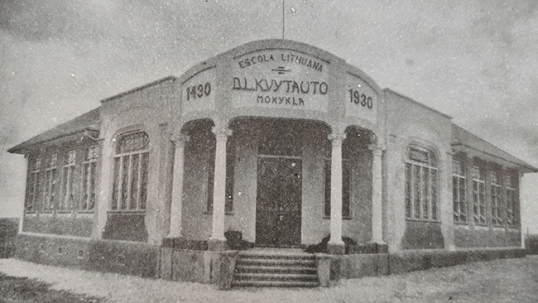
Vytautas the Great school as it looked before World War 2
Another Lithuanian school in Vila Zelina itself - St. Michael the Archangel - has been established in 1938 by Lithuanian Franciscan nuns who arrived from Pittsburgh (USA) under the invitation of a local Lithuanian priest Pijus Ragažnskas. The school is operational; it has some 1000 students in grades ranging from kindergarten to pre-university level.
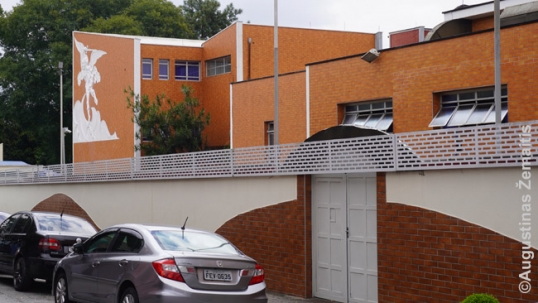
St. Michael the Archangel school in Vila Zelina
The medium of instruction is Portuguese (with some English classes) and the share of Lithuanian pupils declined over time, but Lithuanian surnames are still well visible in the student lists. The school corridors still have historic images of Lithuanian history, while the schoolyard has a post with wishes of peace in 4 languages, among them Lithuanian. The St. Michael the Archangel school remains an important center of the Lithuanian community. Every year, the Lithuanian independence day (February 16th) is celebrated in the school hall by the Vila Zelina community.
The plot of St. Michael the Archangel school also hosts a Franciscan sisters monastery, where the sisters who take care of the school live. The monastery has a "Lithuanian room" with Lithuanian memorabilia and a Lithuanian-inspired cross outside.
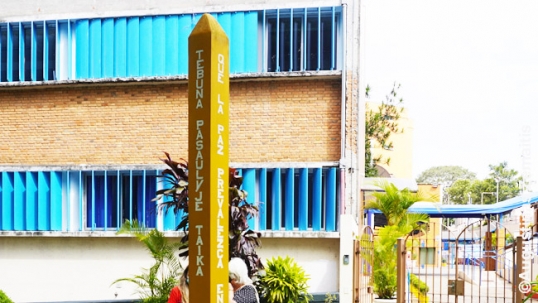
Lithuanian inscription 'Let the peace prevail over the world' in the schoolyard of St. Michael the Archangel
However, the order of Lithuanian Franciscan sisters has undergone similar changes that the school underwent. It had been established in Pittsburgh in 1922: Lithuanian nuns helped with the education and health of the Lithuanian-Americans, as in the USA, these services were expensive. The sisters operated multiple hospitals and many schools. After Lithuanians began migrating to Brazil the order sent some Lithuanian-American nuns to Brazil. However, as time passed, health and pre-university education became free in the USA and the need of the nuns decreased, following by their numbers. In 2017, the motherhouse in Pittsburgh was demolished. In Brazil, however, non-Lithuanians began joining the order - eventually, the main language became Portuguese and the non-Lithuanians formed the majority of nuns. Few Lithuanians are in the order today but the Lithuanian history is still respected. Now the global HQ of this Lithuanian-established order is in Brazil.

This image that hangs on the school wall shows Vila Zelina district during its construction in the 1930s; the Lithuanian church is already built while the rest is still mostly a field. Lithuanian Franciscan nuns stand in front, soon after their arrival to Brazil
Although it is now harder to hear Lithuanian spoken in the Vila Zelina area, a significant part of the local population still consists of the descendants of Lithuanians. Unlike in the USA, Brazilians often spend their entire lifetimes in a single city or district, meaning that Vila Zelina is still largely populated by those, whose forefathers moved there in the interwar or postwar period. One may still often spot Lithuanian surnames adorning the offices of various specialists (e.g. dentists, brokers).

Real estate agency 'Lithuania' in Vila Zelina. ©Augustinas Žemaitis.
The single location that has the most Lithuanian surnames is probably the cemetery Cemiterio Ceramica of the São Caetano do Sul suburb. The cemetery is not Lithuanian-only. However, as it serves as the final resting place for people of the surrounding districts, a significant part of graves belong to Lithuanians. Like in all the Brazilian cemeteries, gravestones are large and often replaced entirely by family chapels (far from just the richest families who own them). However, the cemetery has been damaged by vandals and drug addicts who have stolen a large share of metal plates listing the surnames of the dead.

Cemiterio Ceramica of the São Caetano do Sul suburb. ©Augustinas Žemaitis.

Cemetery. A close-up shot of one of the Lithuanian family chapels. ©Augustinas Žemaitis.
Another, simpler cemetery with Lithuanian burials is the Vila Alpina cemetery.
Lithuanian-Brazilian Union and Mooca district of Sao Paulo
Although Vila Zelina is the symbol of Lithuanian-Brazilians and nowhere in Sao Paulo the Lithuanian history is as evident, only a minority of total Lithuanian-Brazilians lived in Vila Zelina.
The second Sao Paulo district by Lithuanian heritage is the nearby Mooca
There operates the second one of the three major Lithuanian-Brazilian organizations: Lithuanain-Brazilian Union (1931). It has a two-floored edifice with a stylized Vytis whereas the street where the building stands is named after Lithuania (the address is Rua Lituania 67). It is the larger of two Lithuania streets in greater Sao Paulo. Two restaurants/shops next to the Union are also named after Lithuania.

Lithuanian-Brazilian Union building. ©Augustinas Žemaitis.
The building has a library and an archive with various materials and Lithuanian memorabilia from Lithuanian-Brazilians and interwar Lithuania. The hall hosts Lithuanian events. Originally, the building was constructed for Vincas Kudirka Lithuanian school (1929).
Historically, the Lithuanian-Brazilian Union represented leftist Lithuanians.

Restaurant Pricess of Lithuania next to the Union
The religious Lithuanian hub in Mooca used to be the Lithuanian Jesuit house. Currently, the building stands empty but it is still adorned by Crosses of Vytis
The building once housed Lithuanian Jesuits who used to hold mass there in 1968-1978. Formally it was the second Lithuanian parish in Brazil - St. Casimir parish. In contrast to St. Joseph parish of Vila Zelina which served its district, St. Casimir parish was meant to „serve all Lithuanian-Brazilians except those who live in Vila Zelina“. Priests from the Jesuit House would travel throughout Brazil listening to the confessions and doing other religious services. They had a large database of Lithuanian catholic families living throughout Sao Paulo and Brazil.

Cross of Vytis symbols at the Jesuit House (the house itself is beyond the fence)
Such services were especially important while far from every Lithuanian-Brazilian spoke Portuguese. As that generation passed away, however, the need declined and the St. Casimir parish was closed. However, the Jesuit House continued to house Lithuanian priests long after that (Salesians rather than Jesuits). After Lithuania regained independence, however (1990) significant numbers of Lithuanian priests moved from abroad to Lithuania in order to rebuild the Soviet-destroyed parishes and religious life there.
Since 1965, Jesuit house also housed a Lithuanian language school.
Next to the Mooca district, there is Cuarta Parada cemetery where the Lithuanians of the district also were buried. Also, Mooca district houses Sao Paulo museum of immigration which is described in a separate section at the bottom of this article.
Lithuanian-Brazilian schools in the other districts of Sao Paulo
Before World War 2 Lithuanians used to live in at least three more Sao Paulo districts. In each of them, the Lithuanian life used to be centered around Lithuanian schools that were constructed with the support of the interwar Republic of Lithuania: the country sought to ensure that the Lithuanian culture survives among its emigrants to South America.
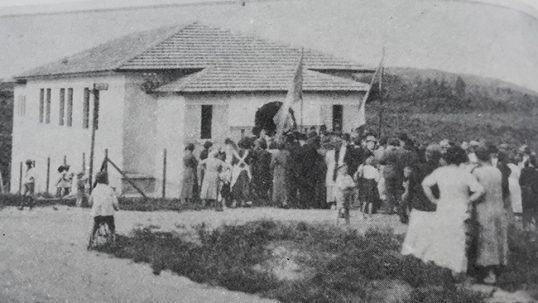
Parque das Nações Maironis Lithuanian school is being opened (historic image)
Unfortunately, Sao Paulo Lithuanian schools operated for a very short time. In 1940, Soviet Union has occupied Lithuania
Parque das Nações district had Maironis Lithuanian school (established 1937, used to own 1000 sq. m land lot, 56 pupils; the building sold after its closure). There is no information if the building survives – if you know, please write in the comments. In this district, Lithuania is still reminded by Lituania street, Lituania bus stop and Vilna street (named after Vilnius, the capital of Lithuania). However, they appeared on the map probably not as much because of Lithuanian influence but rather because all the streets in the district are named after foreign countries and locations.
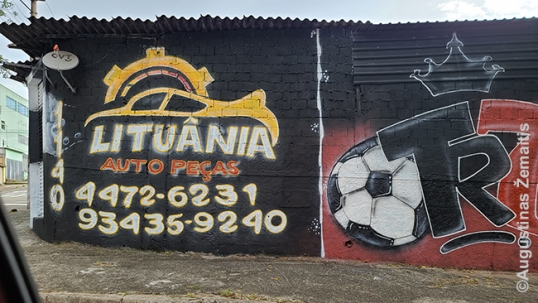
Lituania street in Parque das Nações
Lithuanians had their own school at Bom Retiro district near Sao Paulo center as well (Bandeirantes 92) – currently, an apartment building stands at that address.
The Lithuanian school of the three that survived the longest in Lithuanian ownership was in the Vila Anatacio district 9 km from the center. Named after Jonas Basanavičius and decorated in Lithuanian inscriptions, the building was used for Lithuanian activities long after the school closure. Unfortunately, in 2011 it was sold and demolished.
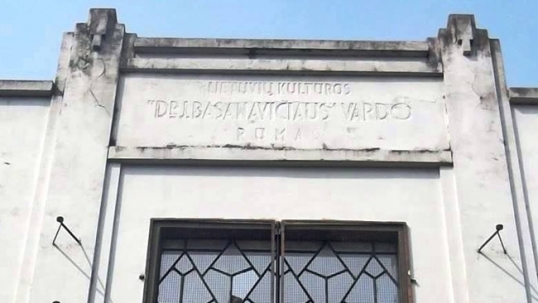
A fragment of J. Basanvičius school building facade with a Lithuanian inscription (now-destroyed). Photo by Alexandre Fejes Neto.
Lituanika, a Lithuanian village near Sao Paulo
Some Sao Paulo suburbs are also teeming in Lithuanian heritage and Lituanika next to Atibaia lacks any peers.
It is the only truly Lithuanian village beyond the borders of Lithuania and neighboring countries!

The gate of Lituanika
The village consists of some 60 homesteads. Originally, all were Lithuanian-owned and today some 80% still are. The total area of Lituanika is 260 000 square meters, i.e. 26 ha.

Lituanika panorama
Even the names of Lituanika streets are related to Lithuania. There is a street named after Darius and Girėnas, the first Lithuanians to cross the Atlantic ocean by plane (their plane was called Lituanica and the entire village is named after it). There is also „Miškų brolių“ (Forest brothers) street named after the partisans

A street name in Lituanika
In addition to the private homes, the village also has numerous Lithuanian public buildings.
A small brick St. Anthony Lithuanian chapel with a belfry, according to a plaque near the entrance, constructed through a donation of priest Dr. Antanas Milius. The chapel interior has a Lithuanian cross and a Lithuanian chapel-post with the sun, a traditional Lithuanian symbol that crossed from the Pagan era into Christian symbolics.

Inside the Lithuanian chapel of Lituanika
A small- hotel-like Guest house (1979), Seniors‘ residence (1992), House of picnics with sleeping places and washrooms (1978), a Lithuanian library (the building highly decorated in Lithuanian wooden ornaments).
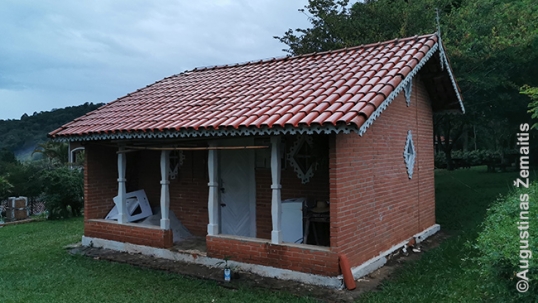
Lithuanian library
Most of the buildings are decorated in Lithuanian style: Lithuanian wooden ornaments and Lithuanian-language inscriptions. As of now, the senior‘s residence and the library are both closed. The Seniors‘ residence has been built on the initiative of a Lithuanian-Brazilian priest Juozas Šeškevičius who spent his own senescence there and took care of other elderly Lithuanians as well as held mass in the chapel for them.
Currently, the chapel and the picnic building are operating only during festivals.
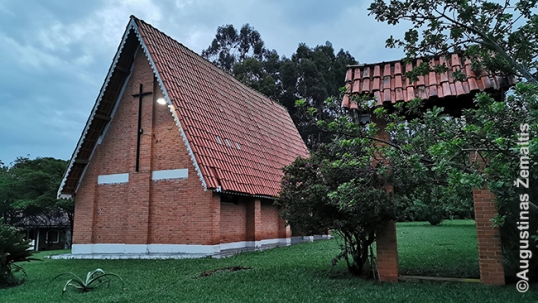
Lithuanian chapel
Many of the Lituanika‘s private houses are also decorated in Lithuanian ways, e.g. Towers of Gediminas. Some have Lithuanian names (e.g. „Marijampolė“ – after a town in Lithuania, „Saulutė“ – little sun)

A house in Lituanika
It also became popular among Lithuanian-Brazilians to get buried in „Lituanika“. Next to the chapel, there is a common Lithuanian grave with a list of Lithuanian names buried there (urns are buried after cremation), among them are several priests from St. Joseph Lithuanian church. Any Lithuanian is allowed to get buried there and this is the only Lithuanian cemetery in Latin America.

Common Lithuanian grave in Lituanika
In addition to Lithuanian spaces, there are numerous spaces for the comfort and relaxation of the inhabitants and guests. A pool (according to a commemorative plaque, built by Jonas Rimša in 1982 03 28), three ponds full of fish for fishing and bathing, an avenue of trees, small forests, and nice views from the heights over the surrounding areas.

Lituanika relaxation zone with a pool and ponds
Lituanika also serves as a venue for Lithuanian events and festivals: not only for the Lituanika residents but (once or twice a year) also for Lithuanians of the whole Sao Paulo (e.g. Joninės celebrations) and once in several years for Lithuanians of the whole South America (e.g. meetings of the South American Lithuanian youth). Usually, the festivities take place in the picnic building where it is also possible to spend a night.

Lituanika symbol at the picnic building
Before ~2005 Lithuanian scout camps used to take place in Lituanika twice a year, attracting ~100 scouts who would camp there.
Lituanika was established in 1977 by two of the three major Lithuanian-Brazilian organizations: the Lithuanian-Brazilian community (ethnic-based) and Lithuanian Catholics (religion-based). Together they have acquired this land using money that they saved during the organization of the Global Lithuanian Congress in Brazil.

A house in Lituanika
Before the 21st century, Lituanika was difficult to reach by road. Typically, Lithuanians would come there for spending summer vacations but currently, some live there all the time. Some Lithuanians sold their properties in Lituanika over time but the goal is to retain the Lithuanian majority. As some Lithuanian sell homes, willing Lithuanian buyers are searched for. Lituanika is a common property of all its inhabitants, as well as the Lithuanian Community and Lithuanian Catholics. According to the Brazilian laws, this means that the owners‘ majority may set the rules that are binding to the rest (e.g. on the styles of private buildings permitted). This helps to retain the Lithuanian character of Lituanika even if a certain share of the buildings is no longer Lithuanian-owned.
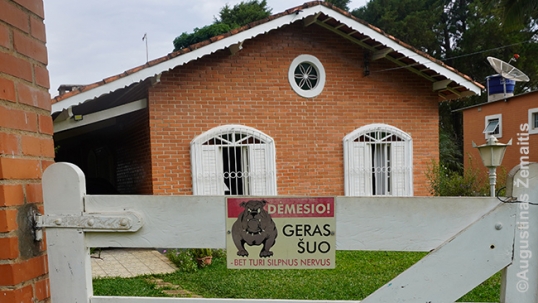
A house in Lituanika
Streets and monuments for Lithuanians all over Brazil
Some Lithuanian-Brazilians have left such a big mark on their cities and towns that streets and squares were named after him. Many of these people are unknown in Lithuania itself.
Basketball player Waldemar Blatkauskas has a street in Campinas, a street in Sao Paulo, and a sports gall in Piracicabas named after him. He represented the Brazilian national basketball team at the times Lithuania was occupied by the Soviet Union and thus had no national team of its own: 1959-1963. Twice he won Olympic bronze with the Brazilian team and twice he won gold at the world championships. In 1963, he died in a car accident. His surname must be very difficult for Brazilians to spell as it appears differently on different plaques even in the same street. Even officially the Campinas street is called „Waldemar Blatkauskas“ whereas the Sao Paulo one „Waldemar Blakauskas“. Other sources also list his name as "Valdemar" and his surname as "Blatskauskas".

Basketball champion Waldemar Blakauskas street in Sao Paulo
Jacarei town of Sao Paulo state has a street named after Vicente Klimeika who is said to have been a famous photographer in the town.
In the Osasco suburb, a street is named after Analice Sakatauskas, a young Lithuanian girl who visited people in poverty or disease and prayed for them. She died riding a bicycle just 19 years old but managed to leave such indelible memory in the city that it has named a street after here.
Analice also probably has a certain folk religiosity aimed towards her, with an Analice Sakatauskas chapel built near the Romeiros road, at 46 km towards Pirapora (-23.412756, -46.950771), the location where she died. The chapel includes a large statue of Christ on top of a small hill and Analice Sakatauskas name. Romeiros road has numerous other religious sculptures on its sides as well.
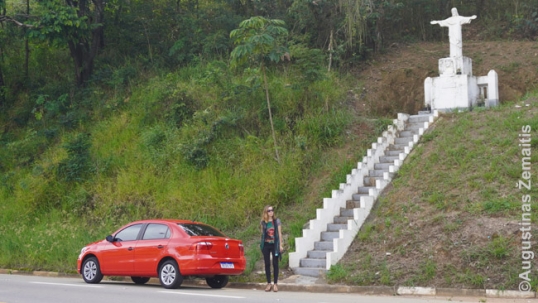
Chapel-monument for Analice Saktauskas at Estrada dos Romeiros

Chapel-monument for Analice Saktauskas at Estrada dos Romeiros

Analice Sakatauskas name on her monument
Sao Paulo also has Vincas Kudirka square. Vincas Kudirka, the author of the Lithuanian national anthem, had nothing to do with Brazil, however, the street was so named under the initiative of Vicente Tubelis, honorary consul of Lithuania in Sao Paulo.

Vincas Kudirka square. As is often the case in Brazil, name (rather than surname) is written in larger letters
A Lithuanian who left the biggest mark in the Sao Paulo area probably was priest Aleksandras (Alexander) Arminas. Initially (1931) he was a priest in Vila Zelina but afterward, he moved into non-Lithuanian Brazilian parishes.
Being a fan of architecture, Arminas often significantly reconstructed the interior of the churches he was a priest at, among them those in Joanopolis (St. John the Baptist) and Piracaia (St. Anthony). Piracaia one was redecorated by Lithuanian artist Navickas. The impressive and unique interior includes a vault covered with images of every pope (with a larger image of the reigning pope, updated every time the pope changes), a Christ image behind the altar with a blinking heart, etc. A plaque near the entrance declares that the renovation was completed by Arminas in 1951.

A fragment of Navickas's ceiling of Piracaia church

Navickas-created interior of the Piracaia church

A commmorative plaque for the reconstruction of Piracaia church, mentioning priest Arminas
The final work of Aleksandras Arminas was the Church of Immaculate conception at Maua suburb of Sao Paulo, where he was a pastor in the years 1954-1975. Arminas is buried there and respected; next to the church Aleksandras Arminas bust stands while the square in front of the church is known as Aleksandras Arminas square. A college he established next to the church is known as Monsignor Alexander V. Arminas College, abbreviated as „Monsignor college“. The priest also wrote Lithuania poetry about Brazil under the nickname of Venacijus Ališas.
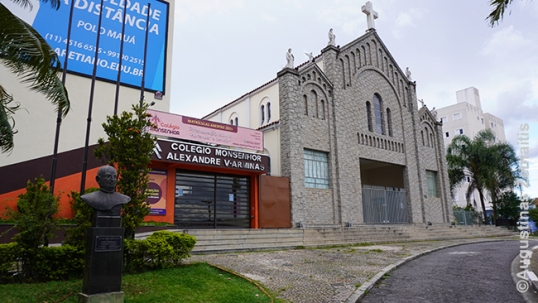
Maua church built by Aleksandras Arminas (on the right), a college named after him (in the middle) and a bust for him (on the left) in Aleksandras Arminas square

Aleksandras Arminas bust (on the left)
Dona Alba street in Raul Soares town of Minas Gerais state may not seem to have anything to do with Lithuania(ns) but, in fact, it is named after a Lithuanian woman Albina Vasiliauskaitė from Sasnava, who, after immigrating to Brazil in 1929, married to a local influential businessman and developer Manoel Maximo Barbosa.
While the majority of interwar Lithuanian immigrants to Brazil would be poor and would have taken free tickets in exchange for free (some say slave-like) work afterward, there were a few who immigrated buying their own tickets and acquired lands in Brazil (that were cheap at the time), becoming rich farmers. Angatuba town in Sao Paulo has streets named after Lithuanian farmers Jonas Vilkas and Antanas Senvaitis (on the street name his surname appears as Senwaittis; on some maps, the names of the streets are turned into Portuguese as Joao Vilka and Antonio Savate).

Jonas Vilkas street in Angatuba
Sorocaba has a viaduct named after Julio Gaidukas, who drowned while trying to save his cousin.
There are streets named after Lithuania all over Brazil, some 30 in total. However, they have little relation to Lithuania and Lithuanians: just like in Parque das Nacoes district of Sao Paulo, they are typically located in areas where streets are named after various countries of the world. Such practice was common during the massive urbanization of Latin America in the 20th century.
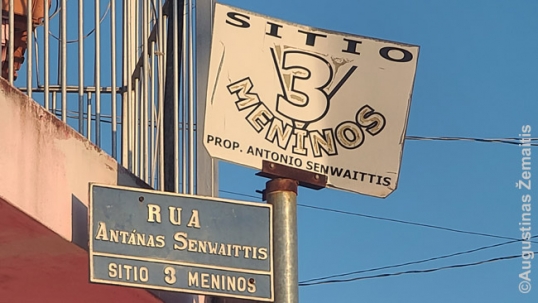
Antanas Senvaitis street in Angatuba
Rio de Janeiro Lithuanian monument
Rio de Janeiro had merely ~500 Lithuanians, but they managed to build a massive Lithuanian Monument dedicated to Lithuanians who died in emigration or exile.
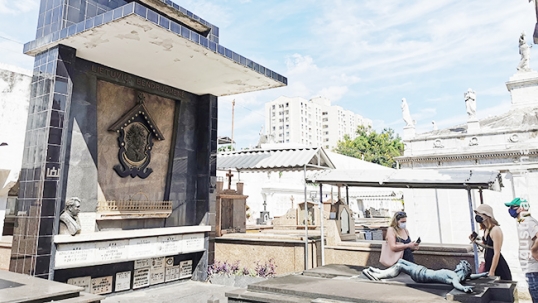
Rio de Janeiro Lithuanian monument in Catumbi cemetery
The monument is easily accessible in the historic Catumbi cemetery among historic graves of the Rio de Janeiro elite. The massive black slab has Lithuanian symbols such as the Coat of Arms, Columns of Gediminas on it, with the Our Lady of Vilnius being the most prominent.
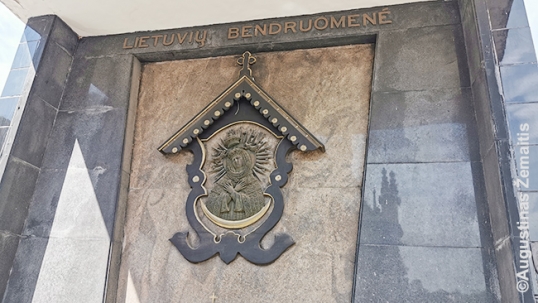
The front of the Rio de Janeiro Lithuanian monument
The monument also serves as a common grave for at least 24 Lithuanians, among them priest Jonas Jamilionis who was the creator of the monument's idea. This makes the monument one of merely two places in the entire Latin America where Lithuanians are buried together based on the ethnic basis (the other such place is in Lituanika).
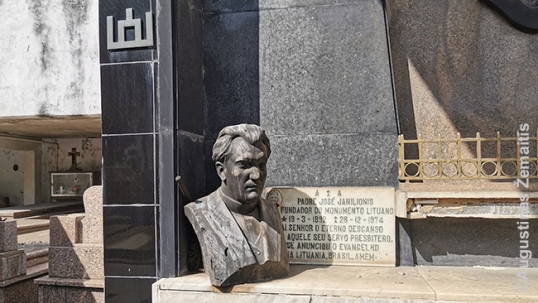
A fragment of the monument with priest Jamilionis bust and Columns of Gediminas
On the front of the monument, those buried under are listed, while priest Jamilionis has his bust. The front of the monument also mentions the Lithuanian Community, one of three key Lithuanian-Brazilian organizations.
The side of the monument has a plaque with its Portuguese dedication, benefactors, and history. The plaque was dedicated in 1965 02 14 for the 400 years of Rio de Janeiro foundation, in the participation of the consul of then-Soviet-occupied Lithuania Frikas Mejeris. The back of the monument has a plaque with dedication in Latin and Lithuanian languages ("This monument is erected to remember Lithuanian emigrant and exile who died abroad. Rio 16/2/1965"). The date inscribed there is not the centenary of Rio (February 14th) but rather Lithuanian independence day (February 16th), however.

Lithuanian commemorative plaque on the back of the Rio de Janeiro Lithuanian monument
Litvak (Jewish) synagogue in Sao Paulo and museums in Brazil
In addition to ethnic Lithuanians, Jews from Lithuania also came to Sao Paulo.
The heart of Litvak religious life in Sao Paulo is Itzhak Elchonon synagogue, established in 1936, with its current modernist building opened in 1956 (Rua Prates 706). It is named after the chief rabbi of Kaunas, Lithuania (Itzhak Elchonon held this position for 32 years: 1864-1896).

Litvak synagogue of Sao Paulo
Unlike many of the synagogues of the Americas where Litvaks participated in the foundation, Sao Paulo Itzhak Elchonono synagogue still is mostly attended by Litvak descendants and keeps its relation with Litvak history and traditions. In most other places of the Americas, Litvaks assimilated into wider local Jewish communities and did not retain a relation with Lithuania in particular or separate Litvak organizations.
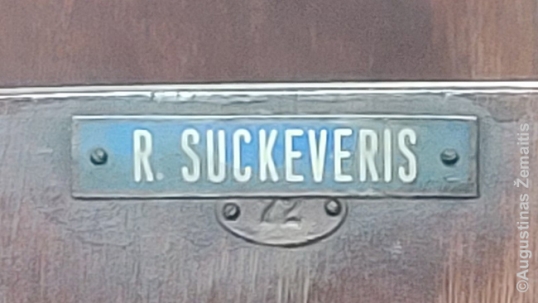
Synagogue pews are traditionally assigned to various people. The plaques on the walls also have names of the deceased synagogue luminaries. Some of the surnames have Lithuanian endings, e.g. is
The synagogue has three floors, the top of which is dedicated to women, the middle of which is the main one for the men while the cellar is a social space with numerous books, as well as artworks created by the synagogue‘s congregation (religious events are also held there these days). The prayers are daily. On the outside of the synagogue stands a large tower with symbols of the 12 tribes of Israel. Such symbols are also on the ceiling of the second floor.

Main floor of the Itzhak Elchonon synagogue
Itzhak Elchonon synagogue stands in Bom Retiro district. In the interwar period, when immigrants from Lithuania would move en masse to Brazil, this used to be a Jewish district. Still, the district has some 10 open synagogues. Jewish immigrants would typically form communities based on the country they immigrated from and established synagogues on this basis.
Over time, in Bom Retiro Jews were more and more replaced by Koreans. The descendants of Litvaks who would move to other districts would often join local synagogues and the Itzhak Elchonon synagogue is thus no longer full but during the Jewish festival, it is still attended by some 70 people.
Arguably the most famous Litvak of Brazil is Lasar Segall, to whom the Lasar Segall museum is dedicated. Some of the works exhibited there are dedicated to Vilnius (the capital of Lithuania), where Segal spent his childhood (he was born in 1891 and emigrated to Germany when 15 years old, later moving to Brazil).

'Houses of Vilnius' by Lasar Segal in the Museum of Lasar Segall in Sao Paulo
Sao Paulo also has a museum of art collections Ema Klabin, while a museum of her sister Eva Klabin stands in Rio De Janeiro. Although it is said that both women were Lithuania‘s Jews, they were born in Brazil; their parents once lived in Lithuania. Expositions have no Lithuania-related details.
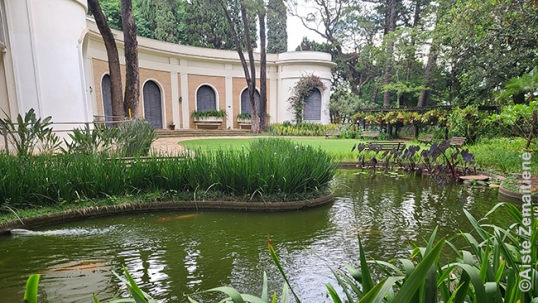
Ema Klabin museum
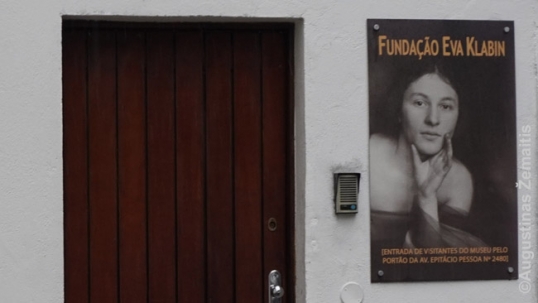
Eva Klabin museum entrance in Rio de Janeiro
Sao Paulo museum of immigration and immigration history
More information about the immigration into Sao Paulo may be discovered at the Immigration museum of Sao Paulo (Rua Visconde de Parnaiba 1316, Mooca) - however, few things of the exposition there are related to Lithuanians in particular. Still, thousands of Lithuanians passed through what is now a museum, as it used to be the building ("guesthouse") where immigrants would be brought in from the Santos port and spend a few days before being taken by their employees (typically to the farms). The museum also has archives where all the immigrants are recorded; the archives are popular among those searching for information about their Lithuanian immigrant relatives.
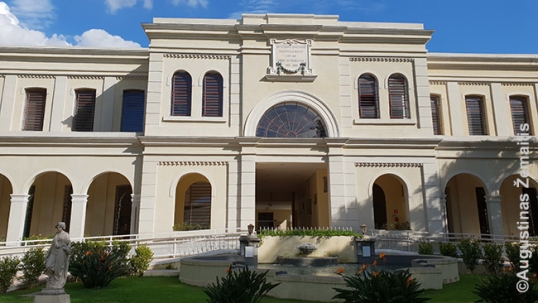
Rather opulent former immigrant guesthouise, now the Museum of Immigration
The true number of Lithuanian-Brazilians is heavily disputed with various sources claiming 30 000, 150 000, 300 000, or even 1 000 000. Presumably, the larger numbers include everyone who had at least a single grandfather or great grandfather from Lithuania. Lithuanian-Brazilian Community election of 1970 had 821 participants, while its counterpart in 1999 had 177 participants (however, the Community is just one of three large Lithuanian organizations in Brazil).
Sao Paulo hosts the only Lithuania's consulate general in Latin America (Avenida Irai, 438, cj. 34). It was established after the Lithuanian embassy in Argentina was closed down as a cost-saving measure in 2013. The larger number of Lithuanian-Brazilians was cited as a reason for the move to Sao Paulo although the decision has received criticism from the Lithuanian-Argentine community which holds itself to be more lively and keen at safeguarding Lithuanian traditions.
In addition to the surviving Lithuanian communities in Sao Paulo, a large share of Lithuanian-Brazilians lived in smaller towns and villages rather than in Sao Paulo. There, they used to be attracted firstly by the promises of cheap lands. These Lithuanian communities largely assimilated over a couple of generations as they always lived intermixed with other larger groups. Lithuanian rural settlement was largely limited to the states of Sao Paulo, Parana, and the Rio Grande do Sul.
The initial migration of Lithuanians to Brazilian villages actually happened even prior to 1918 independence (1870s-1910s) and consisted of some 800 to several thousand people. In the Rio Grande do Sul, these "first wave" Lithuanians participated in the establishment of the Ijui city (pop. 100 000) where they were later joined and outnumbered by other European ethnicities.
In the interwar period, some Lithuanians immigrated in larger groups to form what they called "Lithuanian colonies". Often this was a marketing trick of Brazilian landowners who would advertise their own lands in various European countries promising not only the land itself but also the ability to live among other people from the same country. The most famous of the few "colonies" was arguably Nova Lituania near Costa Machado town (developed by local landowner Dr. Labieno da Costa Machado), while another similar area existed north of Barao do Antonina, both in Sao Paulo state. In any case, little visibly Lithuanian remains there, while "Nova Lituania" name is not included on any maps today: arguably, there were too few Lithuanians or too many of them chose to leave for the cities for these to be viable Lithuanian communities.
In 1925, there were 8146 Lithuanians in Brazil, while in 1930 the number already stood at 40288, showing the massiveness of that key migration wave that defined the Lithuanian-Brazilian community.
In 1954, there were some 50 000 Lithuanian Brazilians, of them 30 000 in Sao Paulo, 20 000 in the countryside, and 300 in Rio. Most were interwar migrants, many once lured in by a free boat trip (in exchange for a long-term contract) and plantation company promises of "American riches" (some believed the entire American continent to be as rich as the USA, while in fact, Brazilian GDP per capita was 1/6th of the US one in 1929 and the wages in Brazil were lower than in Lithuania but cheap land compensated this to some).
500 post-World War 2 refugees in the 1940s became the final major immigration of Lithuanians to Brazil (some of them later emigrated to the USA when it became possible).
According to the 1950s data, among the Lithuanian immigrants, 95% would have married another Lithuanian (some of them were married in Lithuania already). However, in the Brazilian-born generation of their kids, only 32% did so (and that is counting only those who participated in the Lithuanian activities and replied to the questionnaire).

Interwar cups at the premises of Lithuanian-Brazilian Union. ©Augustinas Žemaitis.
Lithuanians of Brazil attracted filmmaker interest. In 2002, the Brazilian documentary Eldorado - Lituanos no Brazil (Eldorado: The Lithuanians in Brazil) was created. Several books on Lithuanian-Brazilians have been published in both Lithuania and Brazil.
Share this:
Language
True Lithuania services
Sister websites
True Lithuania – Extensive website on Lithuania, its culture, cities, history and more
Our Youtube – English videos on Lithuania and interviews with Lithuanians abroad
Destination Lithuanian America – Map of 800+ Lithuanian heritage sites in the USA and Canada
Comments
- Lisa Lapin on New Hampshire
- Reece Lyons on
- Bob Reich on Pittsburgh, Pennsylvania
- Telkom University on Philippines
- Telkom University on Vancouver, British Columbia
Donations
Advertisement
Youtube
Info
- Destination Lithuanian America
- Differences between Lithuanians and neighboring nations
- Divine Mercy: Lithuanian-originated Christian tradition
- Foreign locations named after Lithuania
- Grand Duchy of Lithuania castles abroad
- How to save Lithuanian-American heritage
- Lithuanian camps
- Lithuanian cemeteries abroad
- Lithuanian Churches Abroad
- Lithuanian Convents abroad
- Lithuanian diaspora cuisine
- Lithuanian districts abroad
- Lithuanian Halls abroad
- Lithuanian heritage abroad: what is it?
- Lithuanian minority heritage abroad
- Lithuanian museums abroad
- Lithuanian Schools abroad
- Maps of Lithuanian heritage abroad
- Similarities between Lithuanians and other nations
- Website author Augustinas Žemaitis
- Top Lithuanian locations outside Lithuania
- Lithuanian streets and monuments outside Lithuania
Topics
Andrew / Kunta Kinte island Bar Do Vito Sao Paulo Gardinas Palaces Golshiany Palace Grodno Palaces Kengyr Gulag uprising monument Kosava Palace Krėva / Krevo Palace Lida (Lyda) Castle Lida Palace Lithuanian chapel of Washington National Shrine Lithuanian colonies in Africa Lithuanian colony in Gambia Lithuanian consulate general in Latin America Lithuanian district of Sao Paulo Lithuanian embassy in the USA Lithuanian embassy to the European Union Lithuanian Martyrs chapel in Rome Lithuanian migration to Brazil Lithuanian migration to Uruguay Lithuanian shopping malls in Georgia Lithuanians in Bayonne (New Jersey) Lithuanians in Brazil Lithuanians in Jersey City Lithuanians in Kearny (New Jersey) Lithuanians in St. Lawrence (Verano) cemetary Lithuanian Uruguayan cultural society Lituanica (Lithuania) square in New York City Minnesota Lithuanian community Mir (Myras) Castle Navahrudak (Naugardukas) Castle Nesvizh (Nesvyžius) Palace New Jersey St. Paul and St. Peter Lithuanian church Our Lady of Vilnius chapel in Rome Peshchenlag Lithuanian prisoners monument Ruzhany (Ružanai) Palace St. Michael Lithuanian church Bayonne Steplag Lithuanian prisoners monument Transfiguration church in Brooklyn Transfiguration church in Queens Vila Zelina in Sao Paulo Villa Lituania in Rome Vilnius square in Tbilisi (Georgia) Vilnius University model in Mini-Europe park (Brussels) Wilno village in MinnesotaMain sponsors this year:


Department of Cultural Heritage of Lithuania
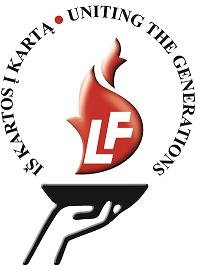

Lithuanian Foundation, Inc.


Press, Radio, and TV Support Fund of Lithuania



May 6th, 2013 - 02:47
Bar do Vito is now run again by Lithuanian heritage owners.
May 7th, 2013 - 19:10
I’m glad to hear that. Have you been there already? Perhaps you have some additional information on Lithuania-related places in Brazil (or Chicago for that matter where you live) which could be added in this or the Illinois article?
September 17th, 2013 - 04:27
Its true! I am a lithuanian decendents!
My grandparents emmigrated to Brazil in 1926, from Vilkaviskis Rajonas!
And actually I am the brazilijos lietuviu Bendruomene prezidentas.
Add my facebook group: esu brazilas ir lietuviu palikuonys.
https://www.facebook.com/groups/125800017432374/
September 19th, 2013 - 06:37
Than you for the information. If you have something on Lithuanian Brazilian heritage (e.g. related buildings, streets, etc.) that you’d like to add – write here and it will be added to the article.
September 19th, 2015 - 16:28
Labas!
I am looking for my grandmother’s sister Ona Lazickaite or her children. Ona emigrated to Brazil from Lazdijai, Lithuania in 1910-1935 (I have nobody to ask about it already). in Brazil she married Sidlauskas and they had 4 daughters. Later she divorsed and raised her girs alone. My mother kept some connections with her long ago. I’d be so interested to know if someone in the Lithuanian community in Brazil have ever heard or met somebody from my grandmother sister’s family. Buciau dekinga labai, Valdemarai, jei man parasytumete !!!!!!!
September 19th, 2015 - 16:30
I have added already the facebook group page of Lithuanians in Brazil to my facebook. Aciu!
January 16th, 2014 - 17:45
sveiki,
domiuosi musu lietuviais emigravusiais i Brazilija ir ieskau giminiu iskeliavusiu tenai. Deja, po keletos laisku, jokios pagalbos is lietuviu bendruomenes negavau. Galbut kas galite patarti kur ieskoti tolliau?
Jurgita
IESKOMA SEIMA: vizgaudai, is Vyzanciu km/Ylakiu km, atkeliave i Sao Paulo apie 1930 ius metus.
dekoju uz pagalba
March 5th, 2014 - 15:24
Jurgita, If you are searching lithuanian family in Brazil, please, add this group in you Facebook!
https://www.facebook.com/groups/125800017432374/
Actually in this group are registered 2.500 decendants!
January 23rd, 2014 - 01:06
I had my DNA tested through DNAtribes.com, and it showed that folks in Brazil share my DNA. I first thought it was the Iberian connection, however, I now realize that it most likely is the Lithuanian relatives. My family names are Kazokas; Simanskas; Pupininkas; Slavinskas; and Turnovich. If anyone shares the same names, feel free to contact me at rochritton@yahoo.com
January 23rd, 2014 - 11:34
Sveiki Augustinai,
Labai smagu, kad kažkas rašo ir domisi apie lietuvių bendruomenę Brazilijoje. Žinoma kaip pats pastebėjote didžioji dalis gyvena San Paulo mieste. Rašau tik norėdama paprašyti, kad pataisytumėte vieną detalę: LR Generalinis Konsulatas San Paulo mieste, teisingas adresas būtų: Av.Iraí 438, cj.34 CEP:04082-001, São Paulo
E-mail: kons.br@mfa.lt.
Dėkojame!
Simona
January 23rd, 2014 - 12:38
Dėkui, pakoreguota. Buvau per klaidą įrašęs garbės konsulo adresą iš URM puslapio.
January 23rd, 2014 - 14:03
cool!!!
that’s it!
February 10th, 2014 - 19:57
Dekoju už įdomų informacinį straipsnį.Apie 1922 metus į Brazilją švyko mano teta ir dėdė Apolonija Vitkauskatė ir Kazimieras Vitkauskas. Žinau,kad teta Apolonija ištekėjusi už Mkailionio ar Mikalūno gyveno San Paule ir turėjo dvi dukras Palmutę r Almutę. Kurios užaugusios itekėjo ž brolių VAZGAUSK-ų . Dabar rada Mykolo Vazgausko pavardę, bet daugiau nieko. Gal kas žinote apie mano puseseres – jų adresus , būčiau dėkingas gavęs, kad galėčiau sukontaktuoti. Aš Algirdas Vitkauskas gyvenu Čikagos priemiestyje Lemonte šalia Pasaulio lietuvių centro, ilgą laiką dirbau korespondentu Drago laikraštyje. Tad lauksiu informacijos mano e-dėžutėje. Dėkoju Visus Brazilijos lietuvius svekinu Vasario 16 mūsų didžiosios tauutinės šventės proga. Linksmų švenčių.
March 5th, 2014 - 15:22
If you are searching lithuanian family in Brazil, please, add this group in you Facebook!
https://www.facebook.com/groups/125800017432374/
Actually in this group are registered 2.500 decendants!
March 5th, 2014 - 15:14
Please,
If you are searching lithuanian family in Brazil, please, add this group in you Facebook!
https://www.facebook.com/groups/125800017432374/
Actually in this group are registered 2.500 decendants!
March 7th, 2014 - 01:07
Labas,as su zmona ir keleta draugu vaziuojame I Brazilija ziureti pasaulio cempionato World Cup 2014 ,planuojame 10 -12 dienu kelione.Gal kas gali padeti patarti,apgyvendinti.Gyvename Chicagoje,tuo paciu galesime atsidekoti jeigu Jus ruosites vaziuoti i JAV, Chicaga.Mes norime aplankyti san Paula ,rio de Zeneira gal dar ka nors-parasykite-lauksiu.Iki.
June 8th, 2014 - 06:41
Informuoju, kad esu išleidusi dvi knygas apie pirmąjį konsulą Brazilijoje dr. Petrą Mačiulį/ 2011/ ir pirmąjį įgaliotą ministrą Brazilijai, Argentinai Joną Aukštuolį 2012/. Knygų turinys paremtas archyviniais dokumentais. Norintiems skaity
ti suteiksiu informacijos. rašykit. Iki malonaus, istorikė Joana Viga Čiplytė, Panevėžys, Lietuva
June 15th, 2014 - 15:56
Sveiki,
Domiuosi magistro studijų galimybės Brazilijoje. Gal kas galite suteikti kokios informacijos? Padės viskas, ką žinote 🙂 Domina Brazilijos universitetų reitingai, diplomų pripažinimas pasaulyje, sąlygos stojimui, studijų sąlygos, mokslo kainos bei pragyvenimo kainos.
August 20th, 2014 - 22:23
I live in Australia and believe that there are families with the name Rakauskas in Sao Paulo and perhaps elsewhere in Brasil. I would like to contact them as my husband immigrated to Australia after WW2 and I would like to find relatives, if any, elsewhere. He was from Garliava and he had two uncles who left Lithuania around the turn of the 20th century for the Americas and they were not heard from again. I am an ethnomusicologist and although not Lithuanian, I wrote my Masters thesis about the Liaudies Dainos in Australia. I am also a grandmother.
Aciu Labai!
August 24th, 2014 - 13:12
Tyrinėju Brazilijoje gyvenusių lietuvių Halinos ir Algirdo Mošinskių asmeninę biblioteką. Gal yra žinančių apie jos likimą po savininkų mirties?
October 19th, 2014 - 01:55
I am searching for relatives of my father-in-law, Vladas Cizauskas, born Liepaja, Latvia, 15 May, 1903.He had an older brother who migrated to Brazil ( Sao Paulo?) in the 1930s, certainly before WW2. They communicated for a number of years after he migrated, probably until the late 1940s or early 1950s. Then, contact was lost. We know the man who went to Sao Paulo married and had two children, a son and a daughter. We have photos of them on bicycles, enjoying the outdoors.
My father-in-law married Vincentine Emilija Ereminaite in Skuodas, Lithuania and they had one son, also named Vladas, born Neustadt, Germany on 19 April, 1945. This family were displaced people after WW2 and eventually came to Australia in 1949.
My father-in-law was a bank worker/manager in Lithuania prior to WW2 and he and Vincentina also lived in Belarus in the early years of their marriage. It would be wonderful to locate relatives of this family member who went to Brazil. We are unsure of his name as his signature is difficult to read on the back of the cards he sent. It may have been Kasis, but we are unsure.
My email address is lynciz@hotmail.com
November 30th, 2014 - 16:49
Sveiki. 2015 sausi zadu vykti i Brazilija. BUtu idomu susitkti su iseiviais. Jeigu yra norinčiu -atsiliepkite.
August 26th, 2015 - 17:27
Sveiki tautiečiai, buvo malonu rasti šiuos pabendravimus.
Spalio š.m. (t. y. 2015m.) Spalio viduryje su savo drauge, kuri yra Brazilė, keliuosi gyventi i Brazilija į Belo Horizonte miestą ir labai norėčiau užmegzti ryšius tiek su Lietuvių bendrija, tiek ir su pačiais lietuviais Belo Horizonte mieste ir kituose miestuose. Gal kas patartumėt kaip galėčiau surasti juos greičiau ir susibendraut su jais artimiau.
dėkui už parama
July 15th, 2016 - 14:29
My grandmother Petronele Mileuska (Miliauskaite) was born on 06/03/1911 in Kuczkininkai, Punsk region of Suwalki, Podlaskie province in Poland. His parents died and went to live in Kalvarija, Lithuania with the uncle. He immigrated to Brazil in 1924.
July 18th, 2016 - 16:51
Neseniai susiradom gimines San Paule. Apie 1930 metus iš Rokiškio rajono išvyko Mockevičių šeima, kuri ten užaugino 5 vaikus. bendravimas buvo nutrūkęs apie 1980 metus, kai mirė lietuvių kalbą mokėję senieji .Dabar bendraujame su jaunimu per interneto vertėją.
July 25th, 2016 - 14:58
I want to correct the date cited at the end of this article i.e. 2012.Beginning 23/09/2011 during five weeks Egidijus Aleksandravicius,Professor of the University Vytautas the Great,Kaunas,Henrikas Gulbinas,Kestas Pikunas and Audris Tatarunas visited places of Lithuanian interest in Brazil.However I was visited on the days 10,11 and 12/10/2011 only by Egidijus Aleksandravicius and Henrikas Gulbinas as Kestas Pikunas and Audris Tatarunas dispensed the Amazon part of the trip.The results were published in the book”Brazilija-lietuviu pokalbiai pasaulio pakrastyje” and 6 serial reports on LRytas.GOD BLESS!
July 25th, 2016 - 17:20
Thank you, the date has been now corrected to 2011.
November 11th, 2016 - 18:20
Ilona
14 zmoniu grupe atskris 2017 sausio 19d i Sao Paulo is Lietuvos pakeliui i Santiago. Ieskome gido ,galincio idomiai papasakoti apie Brazilija ir saugiai supazindinti su Sao Paulo. Isskrendam 20d i Cile.Viesbuti rezervavome netoli orouosto.
Jei turite pasiulymu ir galintys padeti parasykite
January 27th, 2017 - 19:05
My maiden name is Steikunas. My father’s family went to Brazil after WWII. My mother’s parents emigrated in 1926 to Sao Paulo and then moved to Rio de Janerio-last name Bernotavicius. Your site looks interesting!
January 30th, 2017 - 10:07
Hello Augustinas Žemaitis, I am Linguistic Professor at Unioeste, a public university in Paraná, Brazil. I am currently developing a research including place, comercial and personal names of Vila Zelina . The data of your text will be extremely valuable for me. I would like to know if there would be any problem on my using and citing your photos on papers I intend to write to publish the research results
January 30th, 2017 - 11:18
Yes, you may indeed use my pictures, if they would be properly attributed as “Augustinas Žemaitis, http://global.truelithuania.com“. Good luck with you research.
December 10th, 2021 - 12:52
Hello good morning!
The Mural of the Lithuanian Club Montevideo Uruguay, was
1.) Painted by Plastic Artist
Gabriel Vuljevas Tupciauskas.
(next to the mural there is an intervention made by children
supervised by
Gabriel Vuljevas Tupciauskas.
2.) And funded by
AkzoNobel.
3.) The Work of interest is declared by the Ministry of Culture of Uruguay. M.E.C
(Data that your publication or blog should have.
July 2nd, 2017 - 09:28
Sveiki,kur kreiptis del isvykusiu giminaiciu tarpukario metais i SanPaula yra nuotraukos zinomos tu laiku pavardes ir vardai.
July 3rd, 2017 - 01:10
Galite kreiptis į įvardytas Brazilijos lietuvių organizacijas – galbūt dabartinai jų nariai, tarp kurių daug vyresnio amžiaus, pažinos ar prisimins tuos žmones, žinos jų palikuonis.
July 20th, 2017 - 20:52
Sveiki ,
Jieskau giminaiciu Brazilijoje .Tai mano mociutes sesuo Juozapaviciute Verute ( Veronika ) .Ji isvyko is LT 1926 metais .Brazilijoje apsivede su Aleksandru Cheiko ir sugyveno du vaikus Veronika Cheiko ir Kolia Cheiko .Vaikai dabar turetu buti apie 70 metu ,aisku kad jie turi turbut savus vaikus ,apie kuriuos nieko nezinome . Zinome kad jie kadaise gyveno SanPaule . Mano mociutes Vardas Onute Juozapaviciute Petrauskiene . Labai tikiuosi kad padesite mums juos surasti .Dekui Jums labai is anksto .
Pagarbiai
Daiva
November 11th, 2017 - 09:02
Laba diena norėčiau paprasyti jūsų pagalbos rasti didele gimine pavarde Sinkevičius SAN Paolo mieste Brazilijoje labai būčiau dekinga AČIŪ
September 10th, 2019 - 19:06
Laba vakarą,ieškau pagalbos😥,norėčiau supažindinti su savo didelis šeima, kurios niekada nepazinau,tik girdėjau šnekant su tėveliais,norėčiau rasti deduko brolius,kurie emigravo daug metų atgal,ir niekada nepamiršo,turim laiškus tetu rašytus,ir kad turiu didelis šeima ,nerandu kontaktų,niekas negali padėti,būkit geri padėkite jei galit jus man juos rasti,gyvenu Šveicarijoje ❤,Jurgita Sinkeviciute-Marcinonyte Sala,AČIŪ
January 25th, 2021 - 20:29
Sveiki, pažįstu Sinkevičius iš San Paulo miesto.Parašykit man.Dalia
August 21st, 2023 - 20:19
Dalia Jakaitė-aferiste, vagis ir šantažuotoja. As labai su ja nudegiau.
November 5th, 2019 - 15:33
Būtų įdomu surasti mano močiutės Hana Lėja Šneiderytė iš Turagės rajono (aplink Kryžkalnį) pusbrolių ir pusseserių palikuonis. Jos šeima buvo sudeginta vokiečių, ji vienintelė išgyveno.
June 8th, 2020 - 12:25
Sveiki, mano paieškos sukasi apie Benediktą Sugintą – San Paulo lietuvių bažnyčios statytoją ir lietuvių bendruomenės būrėją 1931-1937 metais. Daug laiko praėjo, šiemet 125-osios metinės nuo jo gimimo. Žinau, kad buvo labai populiarus tarp lietuvių, yra daug nuveikęs lietuvių bendruomenės labui. Gal kas pamena pasakojimų apie šį lietuvybei tarnavusį žmogų. Skaičiau, kad lankydavo ne tik San Paulo lietuvius, bet dažnai vykdavo ir į tolimesnes provincijas. Skaičiau apie jį knygą “Tėvynės Vaidila”, bet norėčiau prisiminimų, nugludintų laiko… Gal kas ką girdėjote apie jį?
June 12th, 2020 - 12:22
Sveiki, galite pabandyti susisiekti su kunigu Saulaičiu. Jis dirbo Pietų Amerikoje ilgą laiką ir žino daug istorijų iš ten, ypač apie kunigus. Prieš savo ekspediciją į Pietų Ameriką daug su juo kalbėjome. Dabar jis gyvena Vilniuje.
January 26th, 2021 - 10:53
sveiki, Augustinai, šiuo metu Lietuvos nacionaline biblioteka rengia parodą, skirtą Lietuvos rašytojų įamžinimui. Norėtume paprašyti leidimo panaudoti Jūsų svetainėje esančią nuotrauką su Vinco Kudirkos aikštės pavadinimu / Praca Vincas Kudirka (nr. 34).
January 26th, 2021 - 11:18
Galite naudoti.
Autorystę nurodykite “©Augustinas Žemaitis, http://www.gabaleliailietuvos.lt “. Jei reiktų atsiųsti geresne kokybe, nei turite – rašykite kur.
December 7th, 2021 - 12:05
1927 m Cikanavičiūtės Onutė ir Kotryna emigravo Į Braziliją San Paulo m. gaudavom laiškus iš R.Bepedito Conrado filho ,342 Jd.Beatriz-S.b.c, ieškome giminaičių. Pakvietime į vestuves buvo nurodytos pavardės
OSWALDO GIRIOTAS ,CLEA GODOI GIRIOTAS IR LUIZ ADELSON MARSON BEI JOSEPHINA MARSON, KIEK SUPRATOME JAUNŪJŲ TĖVŲ PAVARDĖS.
December 7th, 2021 - 11:48
Laba diena
Gal galite padėti mums rasti giminaičius,1927 emigravusius i Braziliją, ar galbūt žinote, nuo ko galime pradėti paiešką?